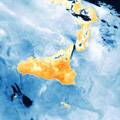Launched on 25 April 2018, Sentinel-3B has already delivered some impressive first images from its ocean and land colour instrument, from its altimeter and from the optical channels of its radiometer. With the radiometer's thermal-infrared channels now turned on, the satellite completes its set of firsts with an image that depicts thermal signatures over southern Italy, the Mediterranean Sea and Sicily – with the hotspot of Mount Etna clearly visible. This image shows the ‘brightness temperature', which corresponds to radiation emitted from the surface. Further processing is needed to turn this into an actual temperature map. The land surface is shown in red–orange colours, corresponding to a brightness temperature range of 296–320K. The blue colours over the ocean correspond to a range of 290–295K. The dark blue–black areas correspond to clouds, which are opaque to thermal-infrared radiation and so prevent a view of the ocean or land surface.
Mount Etna, Europe's largest and most active volcano, appears much hotter than the surrounding land. In a state of almost continuous unrest, the volcano is currently classified as having ‘minor activity'.
Over the oceans, the Sentinel-3 radiometer is important for providing sea-surface temperature measurements for oceanographic and weather forecasting centres. Over land, the instrument can be used, in particular, to monitor urban heat islands and wildfires.

